Victor Zhong
ModelTables: A Corpus of Tables about Models
Dec 18, 2025Abstract:We present ModelTables, a benchmark of tables in Model Lakes that captures the structured semantics of performance and configuration tables often overlooked by text only retrieval. The corpus is built from Hugging Face model cards, GitHub READMEs, and referenced papers, linking each table to its surrounding model and publication context. Compared with open data lake tables, model tables are smaller yet exhibit denser inter table relationships, reflecting tightly coupled model and benchmark evolution. The current release covers over 60K models and 90K tables. To evaluate model and table relatedness, we construct a multi source ground truth using three complementary signals: (1) paper citation links, (2) explicit model card links and inheritance, and (3) shared training datasets. We present one extensive empirical use case for the benchmark which is table search. We compare canonical Data Lake search operators (unionable, joinable, keyword) and Information Retrieval baselines (dense, sparse, hybrid retrieval) on this benchmark. Union based semantic table retrieval attains 54.8 % P@1 overall (54.6 % on citation, 31.3 % on inheritance, 30.6 % on shared dataset signals); table based dense retrieval reaches 66.5 % P@1, and metadata hybrid retrieval achieves 54.1 %. This evaluation indicates clear room for developing better table search methods. By releasing ModelTables and its creation protocol, we provide the first large scale benchmark of structured data describing AI model. Our use case of table discovery in Model Lakes, provides intuition and evidence for developing more accurate semantic retrieval, structured comparison, and principled organization of structured model knowledge. Source code, data, and other artifacts have been made available at https://github.com/RJMillerLab/ModelTables.
SynQuE: Estimating Synthetic Dataset Quality Without Annotations
Nov 06, 2025Abstract:We introduce and formalize the Synthetic Dataset Quality Estimation (SynQuE) problem: ranking synthetic datasets by their expected real-world task performance using only limited unannotated real data. This addresses a critical and open challenge where data is scarce due to collection costs or privacy constraints. We establish the first comprehensive benchmarks for this problem by introducing and evaluating proxy metrics that choose synthetic data for training to maximize task performance on real data. We introduce the first proxy metrics for SynQuE by adapting distribution and diversity-based distance measures to our context via embedding models. To address the shortcomings of these metrics on complex planning tasks, we propose LENS, a novel proxy that leverages large language model reasoning. Our results show that SynQuE proxies correlate with real task performance across diverse tasks, including sentiment analysis, Text2SQL, web navigation, and image classification, with LENS consistently outperforming others on complex tasks by capturing nuanced characteristics. For instance, on text-to-SQL parsing, training on the top-3 synthetic datasets selected via SynQuE proxies can raise accuracy from 30.4% to 38.4 (+8.1)% on average compared to selecting data indiscriminately. This work establishes SynQuE as a practical framework for synthetic data selection under real-data scarcity and motivates future research on foundation model-based data characterization and fine-grained data selection.
Grounded Test-Time Adaptation for LLM Agents
Nov 06, 2025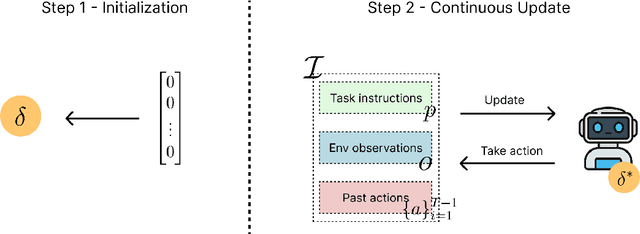
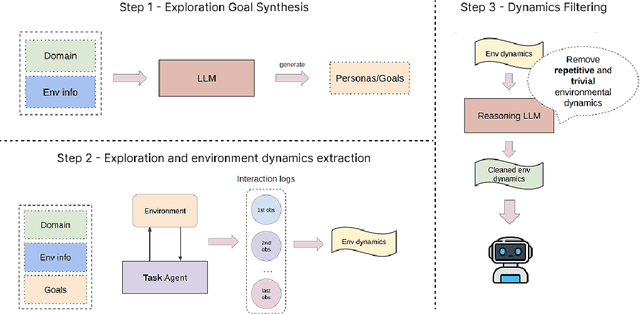
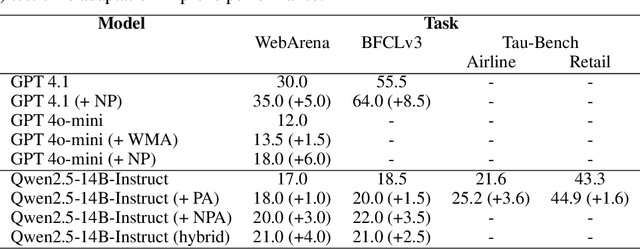

Abstract:Large language model (LLM)-based agents struggle to generalize to novel and complex environments, such as unseen websites or new sets of functions, due to a fundamental mismatch between their pre-training and test-time conditions. This challenge stems from two distinct failure modes: a syntactic misunderstanding of environment-specific components like observation formats, and a semantic misunderstanding of state-transition dynamics, which are only revealed at test time. To address these issues, we propose two distinct and complementary strategies for adapting LLM agents by leveraging environment-specific information available during deployment. First, an online distributional adaptation method parameterizes environmental nuances by learning a lightweight adaptation vector that biases the model's output distribution, enabling rapid alignment with an environment response format. Second, a deployment-time dynamics grounding method employs a persona-driven exploration phase to systematically probe and learn the environment's causal dynamics before task execution, equipping the agent with a nonparametric world model. We evaluate these strategies across diverse agentic benchmarks, including function calling and web navigation. Our empirical results show the effectiveness of both strategies across all benchmarks with minimal computational cost. We find that dynamics grounding is particularly effective in complex environments where unpredictable dynamics pose a major obstacle, demonstrating a robust path toward more generalizable and capable LLM-based agents. For example, on the WebArena multi-site split, this method increases the agent's success rate from 2% to 23%.
OpenCUA: Open Foundations for Computer-Use Agents
Aug 12, 2025Abstract:Vision-language models have demonstrated impressive capabilities as computer-use agents (CUAs) capable of automating diverse computer tasks. As their commercial potential grows, critical details of the most capable CUA systems remain closed. As these agents will increasingly mediate digital interactions and execute consequential decisions on our behalf, the research community needs access to open CUA frameworks to study their capabilities, limitations, and risks. To bridge this gap, we propose OpenCUA, a comprehensive open-source framework for scaling CUA data and foundation models. Our framework consists of: (1) an annotation infrastructure that seamlessly captures human computer-use demonstrations; (2) AgentNet, the first large-scale computer-use task dataset spanning 3 operating systems and 200+ applications and websites; (3) a scalable pipeline that transforms demonstrations into state-action pairs with reflective long Chain-of-Thought reasoning that sustain robust performance gains as data scales. Our end-to-end agent models demonstrate strong performance across CUA benchmarks. In particular, OpenCUA-32B achieves an average success rate of 34.8% on OSWorld-Verified, establishing a new state-of-the-art (SOTA) among open-source models and surpassing OpenAI CUA (GPT-4o). Further analysis confirms that our approach generalizes well across domains and benefits significantly from increased test-time computation. We release our annotation tool, datasets, code, and models to build open foundations for further CUA research.
Spider 2.0: Evaluating Language Models on Real-World Enterprise Text-to-SQL Workflows
Nov 12, 2024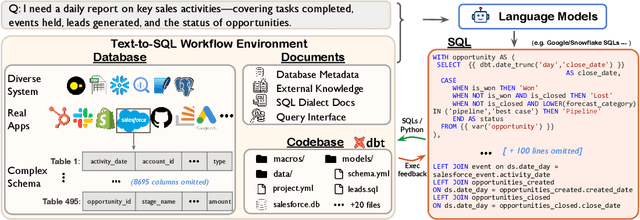

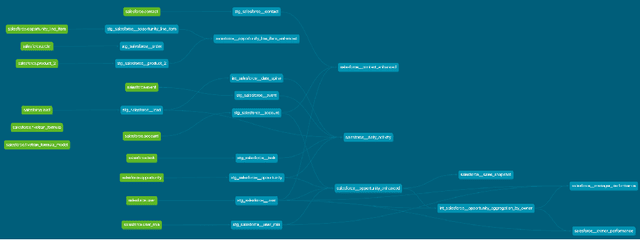

Abstract:Real-world enterprise text-to-SQL workflows often involve complex cloud or local data across various database systems, multiple SQL queries in various dialects, and diverse operations from data transformation to analytics. We introduce Spider 2.0, an evaluation framework comprising 632 real-world text-to-SQL workflow problems derived from enterprise-level database use cases. The databases in Spider 2.0 are sourced from real data applications, often containing over 1,000 columns and stored in local or cloud database systems such as BigQuery and Snowflake. We show that solving problems in Spider 2.0 frequently requires understanding and searching through database metadata, dialect documentation, and even project-level codebases. This challenge calls for models to interact with complex SQL workflow environments, process extremely long contexts, perform intricate reasoning, and generate multiple SQL queries with diverse operations, often exceeding 100 lines, which goes far beyond traditional text-to-SQL challenges. Our evaluations indicate that based on o1-preview, our code agent framework successfully solves only 17.0% of the tasks, compared with 91.2% on Spider 1.0 and 73.0% on BIRD. Our results on Spider 2.0 show that while language models have demonstrated remarkable performance in code generation -- especially in prior text-to-SQL benchmarks -- they require significant improvement in order to achieve adequate performance for real-world enterprise usage. Progress on Spider 2.0 represents crucial steps towards developing intelligent, autonomous, code agents for real-world enterprise settings. Our code, baseline models, and data are available at https://spider2-sql.github.io.
Spider2-V: How Far Are Multimodal Agents From Automating Data Science and Engineering Workflows?
Jul 15, 2024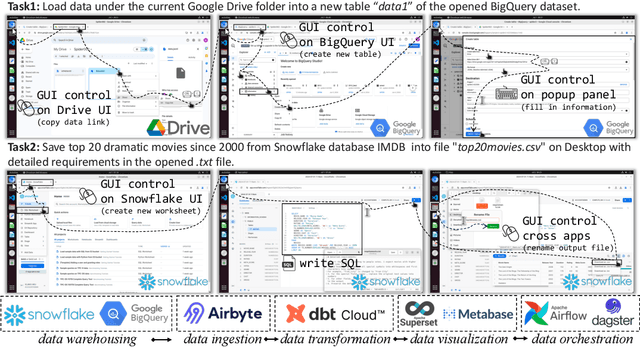
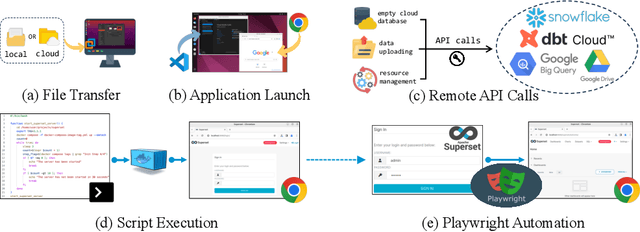
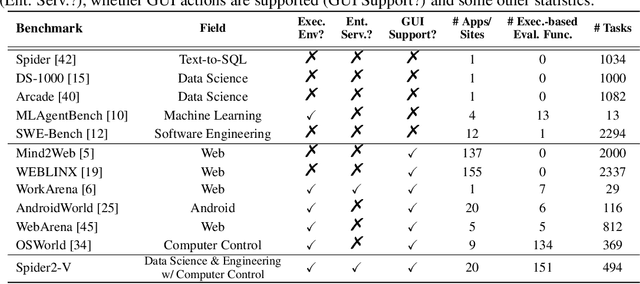
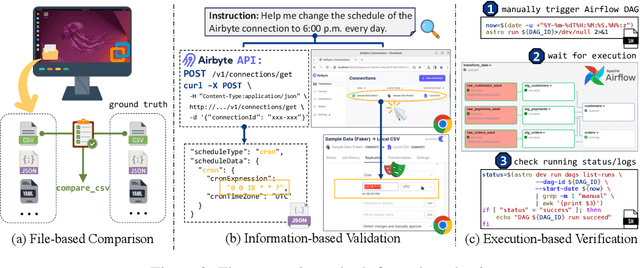
Abstract:Data science and engineering workflows often span multiple stages, from warehousing to orchestration, using tools like BigQuery, dbt, and Airbyte. As vision language models (VLMs) advance in multimodal understanding and code generation, VLM-based agents could potentially automate these workflows by generating SQL queries, Python code, and GUI operations. This automation can improve the productivity of experts while democratizing access to large-scale data analysis. In this paper, we introduce Spider2-V, the first multimodal agent benchmark focusing on professional data science and engineering workflows, featuring 494 real-world tasks in authentic computer environments and incorporating 20 enterprise-level professional applications. These tasks, derived from real-world use cases, evaluate the ability of a multimodal agent to perform data-related tasks by writing code and managing the GUI in enterprise data software systems. To balance realistic simulation with evaluation simplicity, we devote significant effort to developing automatic configurations for task setup and carefully crafting evaluation metrics for each task. Furthermore, we supplement multimodal agents with comprehensive documents of these enterprise data software systems. Our empirical evaluation reveals that existing state-of-the-art LLM/VLM-based agents do not reliably automate full data workflows (14.0% success). Even with step-by-step guidance, these agents still underperform in tasks that require fine-grained, knowledge-intensive GUI actions (16.2%) and involve remote cloud-hosted workspaces (10.6%). We hope that Spider2-V paves the way for autonomous multimodal agents to transform the automation of data science and engineering workflow. Our code and data are available at https://spider2-v.github.io.
OSWorld: Benchmarking Multimodal Agents for Open-Ended Tasks in Real Computer Environments
Apr 11, 2024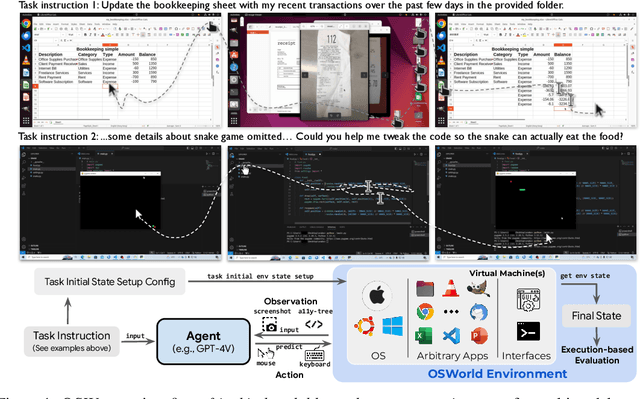
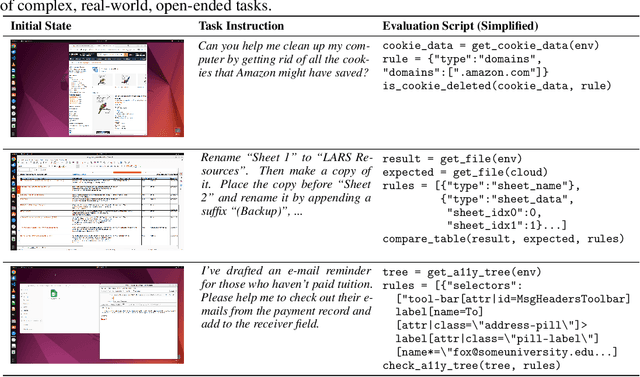
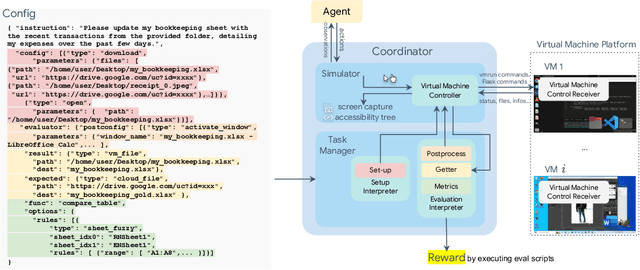
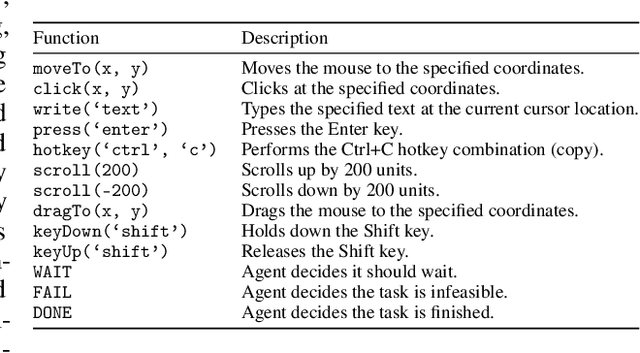
Abstract:Autonomous agents that accomplish complex computer tasks with minimal human interventions have the potential to transform human-computer interaction, significantly enhancing accessibility and productivity. However, existing benchmarks either lack an interactive environment or are limited to environments specific to certain applications or domains, failing to reflect the diverse and complex nature of real-world computer use, thereby limiting the scope of tasks and agent scalability. To address this issue, we introduce OSWorld, the first-of-its-kind scalable, real computer environment for multimodal agents, supporting task setup, execution-based evaluation, and interactive learning across various operating systems such as Ubuntu, Windows, and macOS. OSWorld can serve as a unified, integrated computer environment for assessing open-ended computer tasks that involve arbitrary applications. Building upon OSWorld, we create a benchmark of 369 computer tasks involving real web and desktop apps in open domains, OS file I/O, and workflows spanning multiple applications. Each task example is derived from real-world computer use cases and includes a detailed initial state setup configuration and a custom execution-based evaluation script for reliable, reproducible evaluation. Extensive evaluation of state-of-the-art LLM/VLM-based agents on OSWorld reveals significant deficiencies in their ability to serve as computer assistants. While humans can accomplish over 72.36% of the tasks, the best model achieves only 12.24% success, primarily struggling with GUI grounding and operational knowledge. Comprehensive analysis using OSWorld provides valuable insights for developing multimodal generalist agents that were not possible with previous benchmarks. Our code, environment, baseline models, and data are publicly available at https://os-world.github.io.
Policy Improvement using Language Feedback Models
Feb 25, 2024



Abstract:We introduce Language Feedback Models (LFMs) that identify desirable behaviour - actions that help achieve tasks specified in the instruction - for imitation learning in instruction following. To train LFMs, we obtain feedback from Large Language Models (LLMs) on visual trajectories verbalized to language descriptions. First, by using LFMs to identify desirable behaviour to imitate, we improve in task-completion rate over strong behavioural cloning baselines on three distinct language grounding environments (Touchdown, ScienceWorld, and ALFWorld). Second, LFMs outperform using LLMs as experts to directly predict actions, when controlling for the number of LLM output tokens. Third, LFMs generalize to unseen environments, improving task-completion rate by 3.5-12.0% through one round of adaptation. Finally, LFM can be modified to provide human-interpretable feedback without performance loss, allowing human verification of desirable behaviour for imitation learning.
Text2Reward: Automated Dense Reward Function Generation for Reinforcement Learning
Sep 21, 2023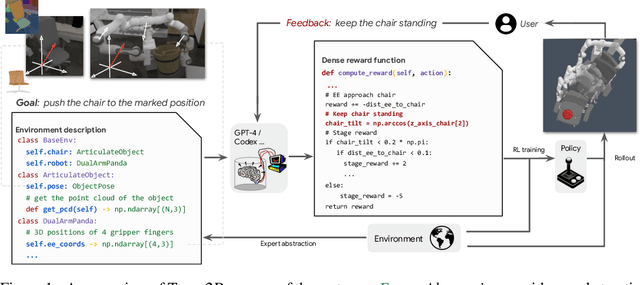
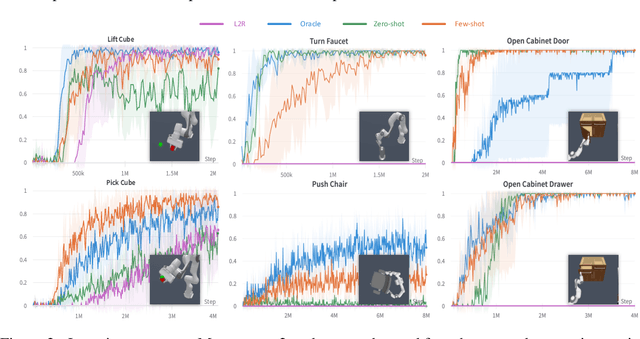
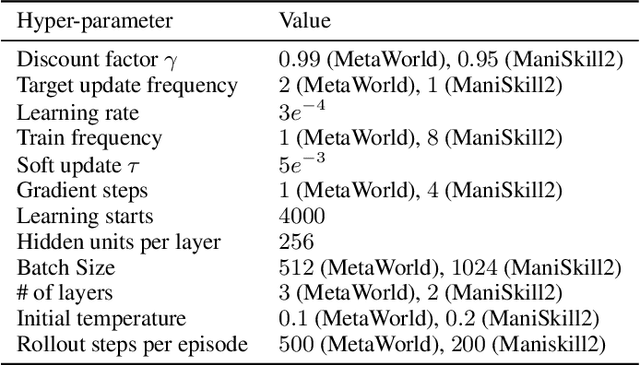
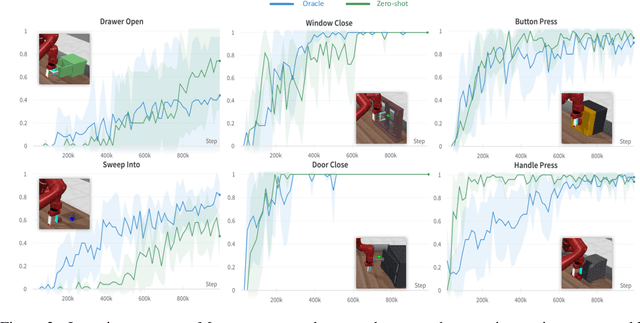
Abstract:Designing reward functions is a longstanding challenge in reinforcement learning (RL); it requires specialized knowledge or domain data, leading to high costs for development. To address this, we introduce Text2Reward, a data-free framework that automates the generation of dense reward functions based on large language models (LLMs). Given a goal described in natural language, Text2Reward generates dense reward functions as an executable program grounded in a compact representation of the environment. Unlike inverse RL and recent work that uses LLMs to write sparse reward codes, Text2Reward produces interpretable, free-form dense reward codes that cover a wide range of tasks, utilize existing packages, and allow iterative refinement with human feedback. We evaluate Text2Reward on two robotic manipulation benchmarks (ManiSkill2, MetaWorld) and two locomotion environments of MuJoCo. On 13 of the 17 manipulation tasks, policies trained with generated reward codes achieve similar or better task success rates and convergence speed than expert-written reward codes. For locomotion tasks, our method learns six novel locomotion behaviors with a success rate exceeding 94%. Furthermore, we show that the policies trained in the simulator with our method can be deployed in the real world. Finally, Text2Reward further improves the policies by refining their reward functions with human feedback. Video results are available at https://text-to-reward.github.io
When Not to Trust Language Models: Investigating Effectiveness and Limitations of Parametric and Non-Parametric Memories
Dec 20, 2022Abstract:Despite their impressive performance on diverse tasks, large language models (LMs) still struggle with tasks requiring rich world knowledge, implying the limitations of relying solely on their parameters to encode a wealth of world knowledge. This paper aims to understand LMs' strengths and limitations in memorizing factual knowledge, by conducting large-scale knowledge probing experiments of 10 models and 4 augmentation methods on PopQA, our new open-domain QA dataset with 14k questions. We find that LMs struggle with less popular factual knowledge, and that scaling fails to appreciably improve memorization of factual knowledge in the tail. We then show that retrieval-augmented LMs largely outperform orders of magnitude larger LMs, while unassisted LMs remain competitive in questions about high-popularity entities. Based on those findings, we devise a simple, yet effective, method for powerful and efficient retrieval-augmented LMs, which retrieves non-parametric memories only when necessary. Experimental results show that this significantly improves models' performance while reducing the inference costs.
 Add to Chrome
Add to Chrome Add to Firefox
Add to Firefox Add to Edge
Add to Edge